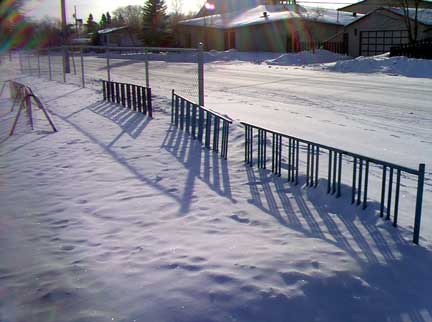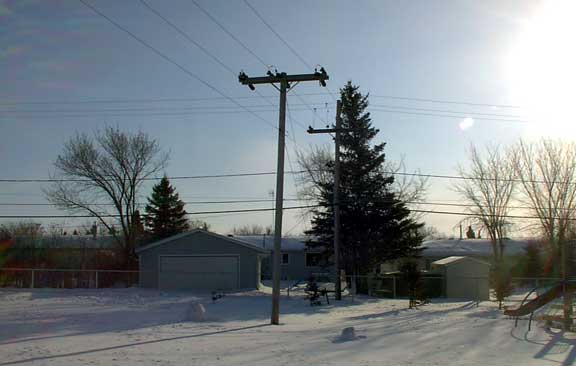|
Above Ground Pollution |
 |
| FTLComm - Tisdale - February 25, 2001 |
 I walked
over to the elementary I walked
over to the elementary school this morning to shoot some pictures of the empty playground. The story had the kind of intellectual and philosophical premise that interests me being that what is this space about when it is not a children's playground. The cold air and sharp contrast of the morning light added somewhat to the drama of the idea and the shadows and concept of the empty bicycle parking racks looked both interesting and fit in with the theme I wanted to discuss. So much of our world is about what it is not. We have bike racks for bicycles but for much more than half the school year no bicycles can be used. We have huge spaces set aside |
| for parks and playgrounds |
 that are
so much a part of life that are
so much a part of life and are absolutely vital yet those spaces are used for only a fraction of the time in each day, week, month or year. It is a sort of puzzle and something we need to both think about and understand how we might make better use of the space and time continuum The tantalizing images of the play ground really are interesting in that the evidence of the real owners and uses of the playground is everywhere only slightly masked by the subtle dusting of powdery snow that softens the scene and smoothes the shadows. But as I tried to get the best shoots of the playground I |
| found myself distracted with the overhead spaghetti In every picture there were power lines, telephone lines, video cable lines, power poles and transformers. Each picture seemed more about these lines of one kind or another than anything else. Wolseley Saskatchewan was the first town to have all of its electrical and communications lines installed in the ground, rather than above the ground. There was a time during the early 80s when SaskPower set about putting all of its overhead rural lines into the ground. But somewhere in the late 80s in the Assiniboia area it was decided that it was going to cost to much money and the whole process was abandoned. |
 |
| However, within towns and villages all new subdivisions usually are developed with underground electrical and telephone connections. In Tisdale the whole process is a mixture of things. In most of the town the electrical, telephone and cable lines are carried on overhead poles down the back alleys. From the need to constantly maintain these overhead lines one wonders at the cost savings as they seem to always hacking down trees and after every wind or ice storm broke dangerous lines fall on the ground around the community. Much of the telephone service seems to be underground, at least the major trunk lines while the individual home service is still carried on overhead lines. |
 |
| When you realise the amount of electromagnet fields that circle every wire it certainly gives a person pause to consider just what affect that might have on people who will spend more than half an hour of each school day playing in that electromagnet field. As you can see in the picture above the lines do not only pass over the school yard to the school but then exit the yard on a Northern route to serve other dwellings using the transformers stationed above the school playground. |
 This picture and the one below illustrates the plan involved. The matrix of electrical and other cables are run down the back alley and over the school playground while underground lines have been installed to provide more aesthetically pleasing front yard views running to the street lights. Some how this makes little sense to me if SaskPower can do the street lighting in this manner why is it still running the overhead lines down the back alleys and especially over the children's playground? |
 The temporary nature of our world is so often distressing when we consider that there is no reason to assume that people will only live in this neighbourhood during our lifetime. Would it not seem far more appropriate to spend the extra money if that is what is necessary to bury these cables and make things not only look better but perhaps even afford greater safety and protect everyone from the hinted and suspicion of damage from high voltage overhead lines? |
 |
|
Timothy W. Shire |